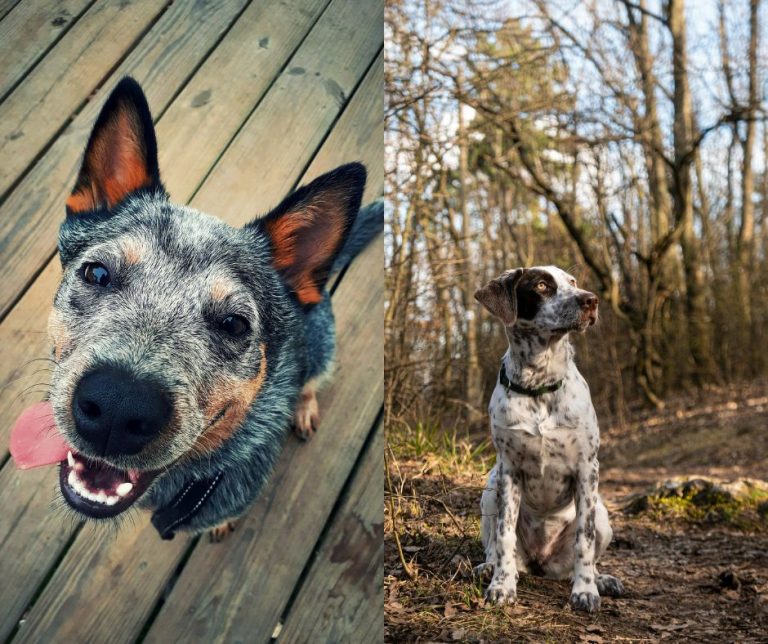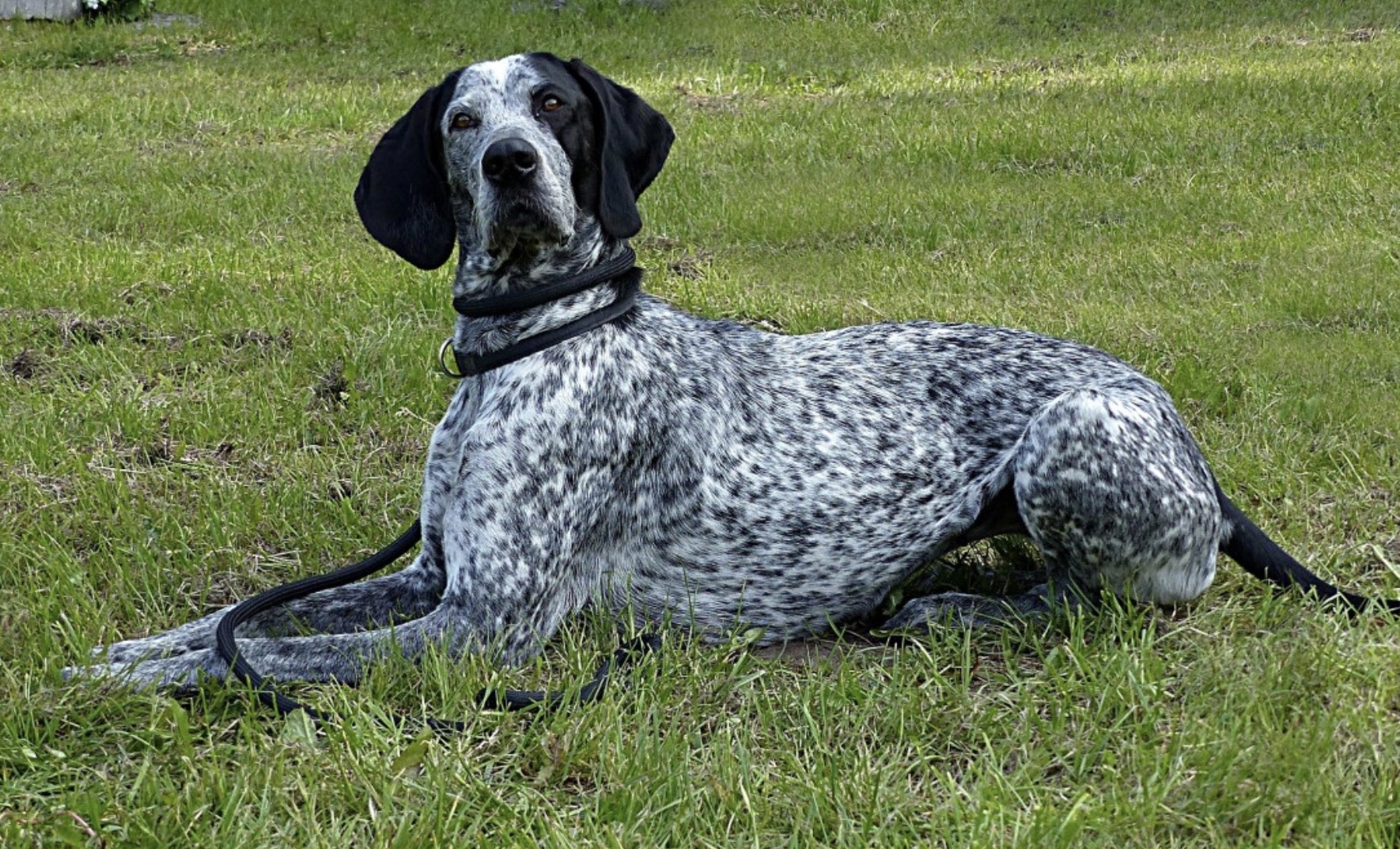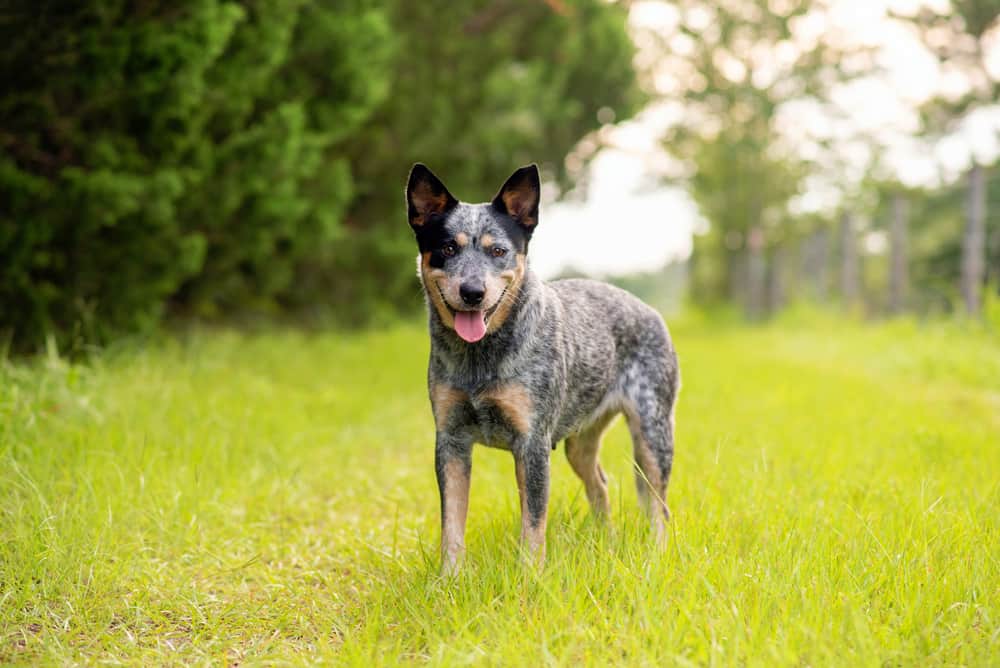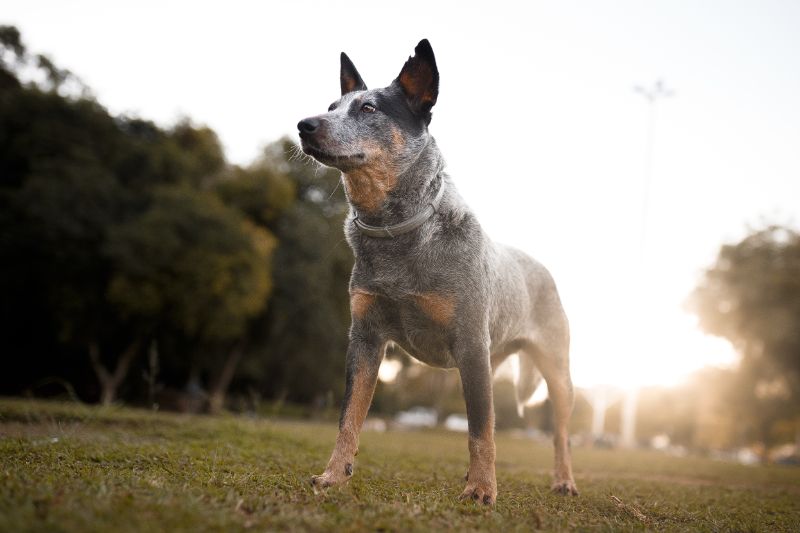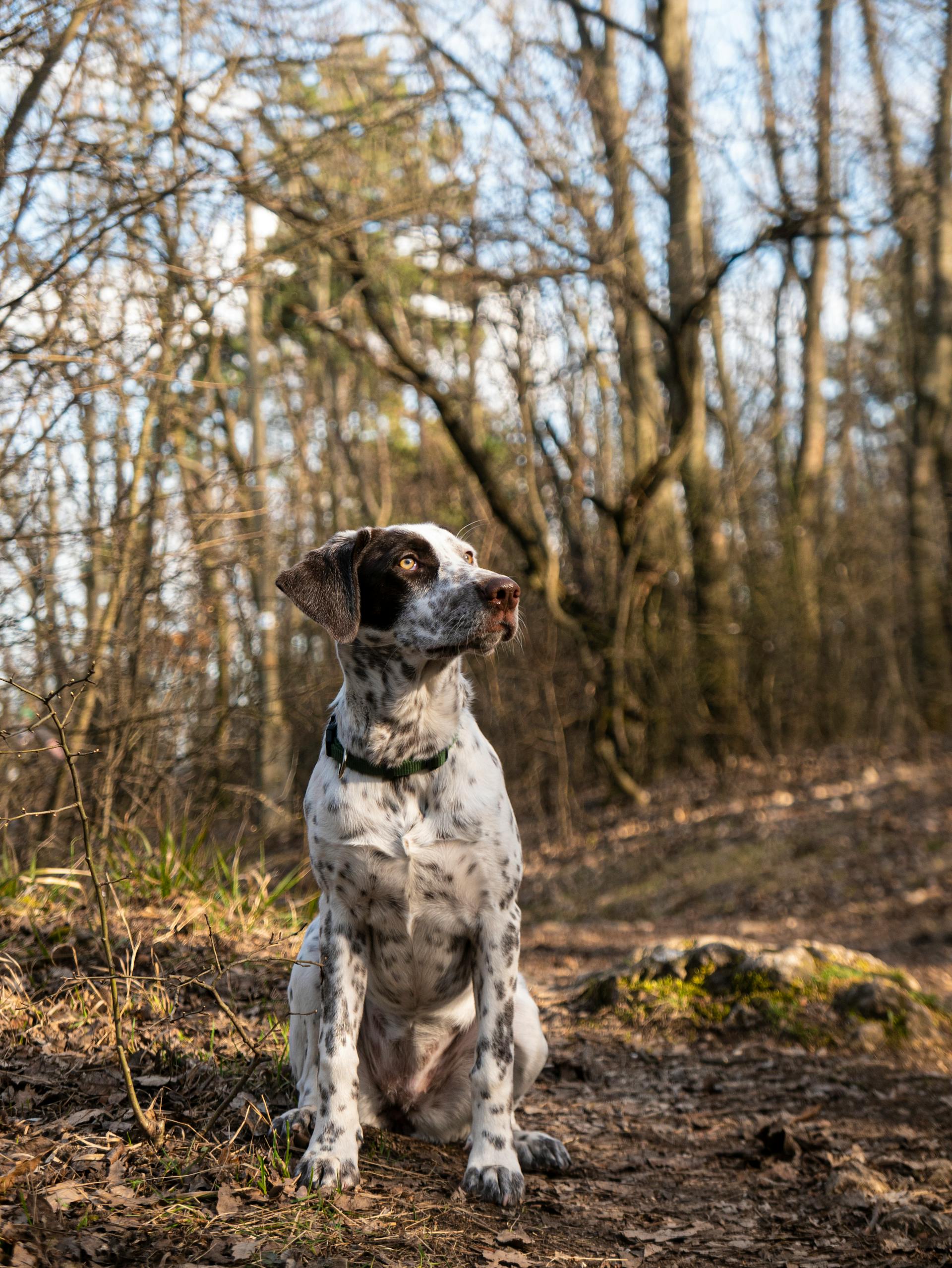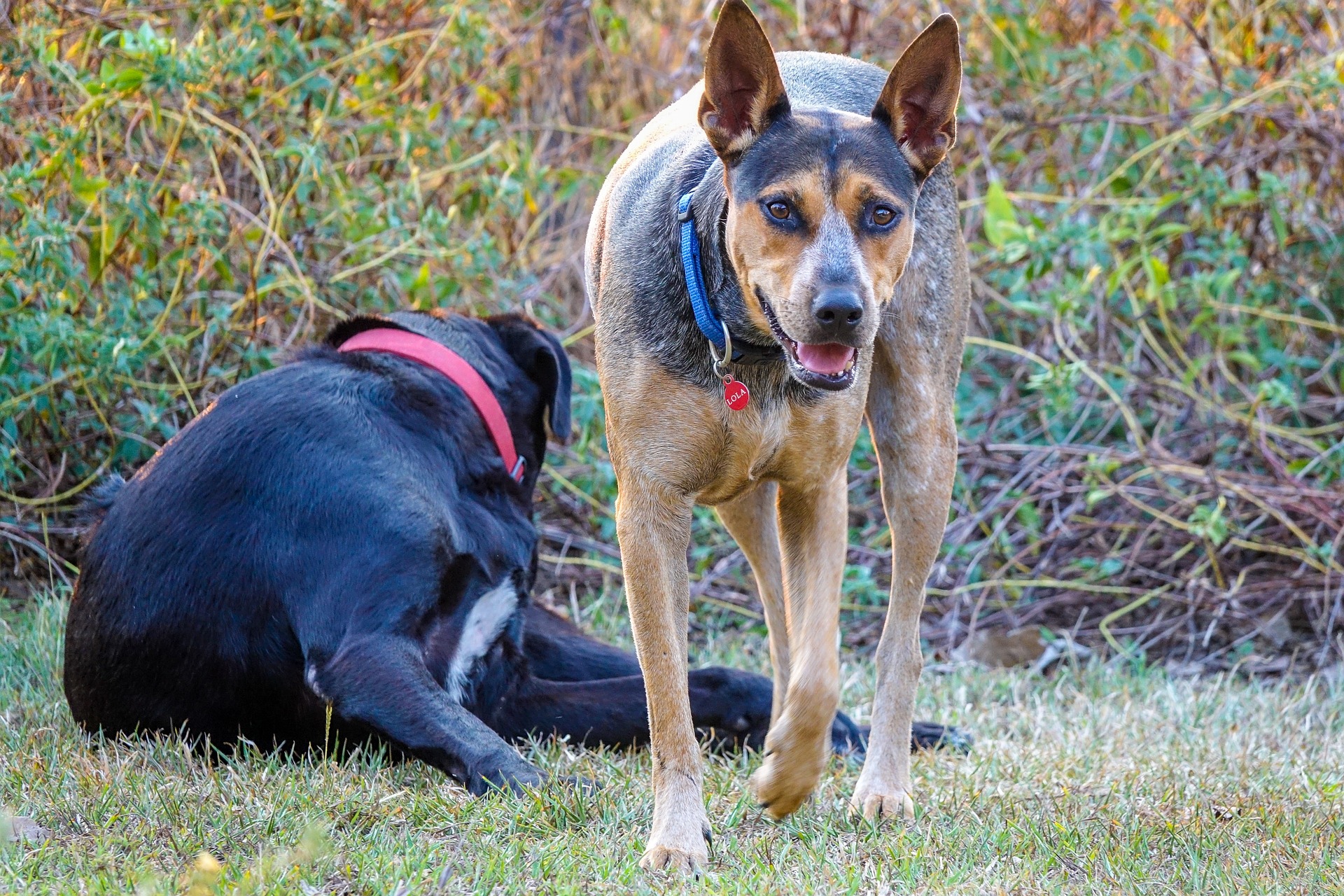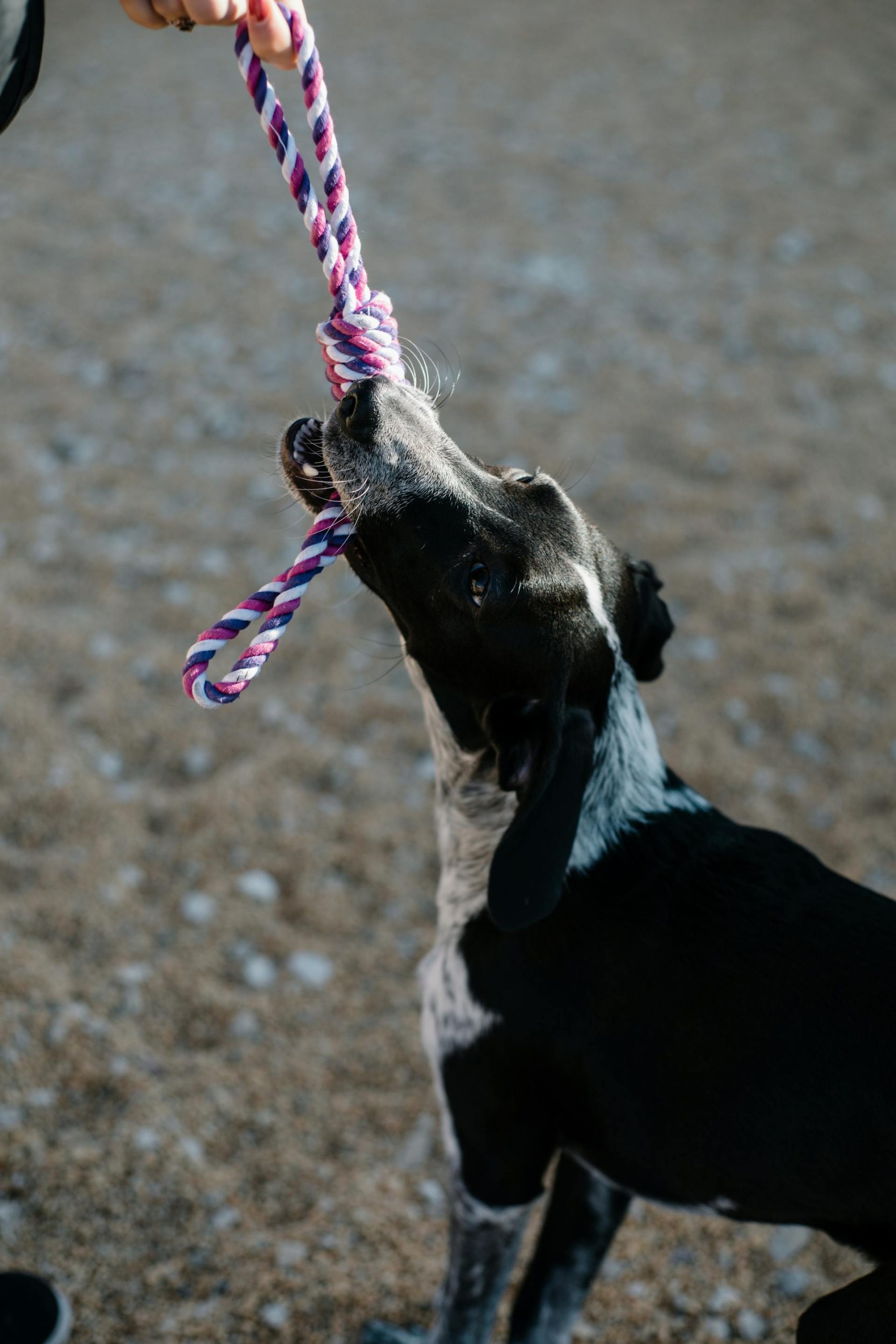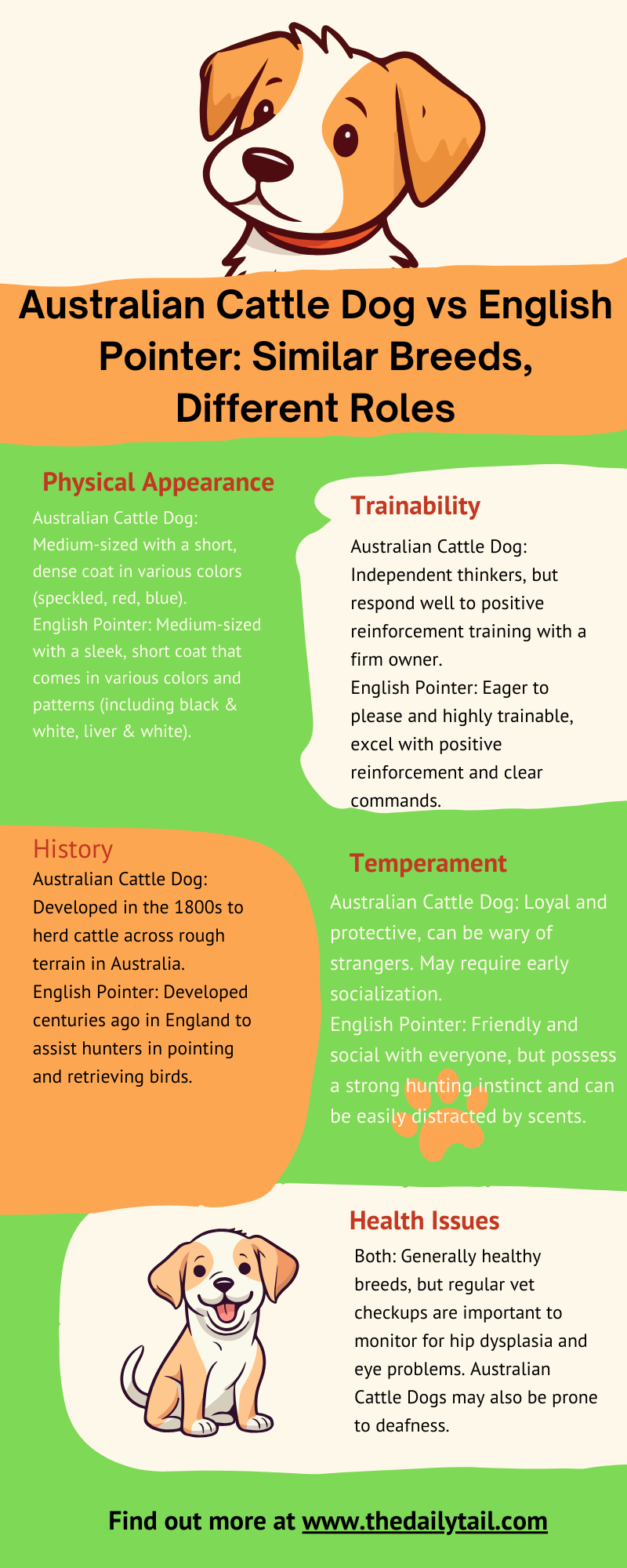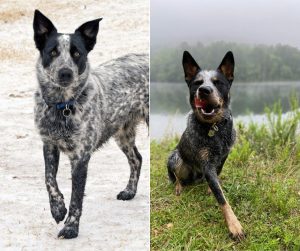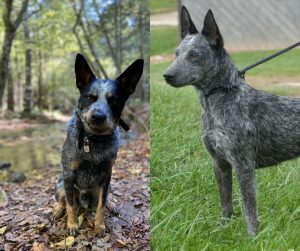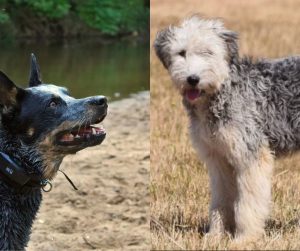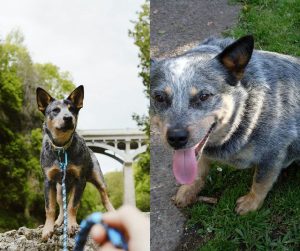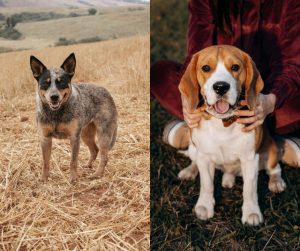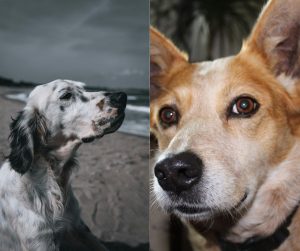Today, I want to look at two breeds that were bred for different working roles. When we talk about working dog breeds, we forget to mention that there are different roles for working. Some working dog breeds like the Australian Cattle Dog were bred for herding and helping farmers. Others, like the Pointer, were bred to assist hunting. A job is a job. And a task is a task. So, let’s take a look at the Australian Cattle Dog vs English Pointer dog breed comparison.
The Australian Cattle Dog originates from the rugged Australian outback, bred to be a tireless cattle wrangler. Think of them as the feisty, workaholic friend who’s always ready to get the job done.
Meanwhile, the English Pointer, with its roots in the UK countryside, is like the elegant, keen-nosed athlete of the dog world. They’re all about tracking and finding – always ready for an adventure!
Each dog breed brings something special to the table, so to speak. The Australian Cattle Dog, while a bit smaller than the Pointer, lives just as long and is built tough – just what you need for those demanding farm chores. On the other hand, the Pointer wins in the sleekness department, ideal if you’re an active person who loves to spend time outdoors.
Recognizing the significance of exercise, training, and the compatible living conditions can guide potential owners in deciding which dog would integrate seamlessly into their home and daily routine.
Key Takeaways
- The Australian Cattle Dog was bred for herding while the English Pointer excels in hunting.
- Physical and lifespan similarities exist, but activity needs and temperaments differ.
- Considering exercise, training, and living conditions helps in choosing the right breed.
History and Origins
In comparing the Australian Cattle Dog and the English Pointer, we’re not just looking at two different dog breeds but also two distinct histories, each rooted in the working lives of dogs in their respective countries.
These dogs were not just pets but partners in work, bred for specific tasks that required intelligence, endurance, and temperament.
Australian Cattle Dog History
As the name suggests, the canine originates from Australia. Down there, they need a breed to handle herding duties on expansive ranches. Breeders began crossing the native Australian Dingo with other dogs. And that is how we got the Australian Cattle Dog breed. Nowadays, we make a distinction between Blue Heeler and Red Heeler. The main difference is coat color. But either of those is an Australian Cattle Dog.
These resilient canines were bred to drive cattle over long distances in harsh conditions, earning them the affectionate name “Queensland Heeler.” Thomas Hall was the one responsible for breeding this dog. In addition to Queensland Heeler, a lot of people recognize him as Halls Heeler as well.
English Pointer Origins
The English Pointer, originating from England, has a different tale. This canine began as a gun dog breed, adept in aiding hunters by pointing to game birds with a distinctive stance. For years, he fulfilled his role as a sporting companion, celebrated for agility, grace, and focus during a hunt.
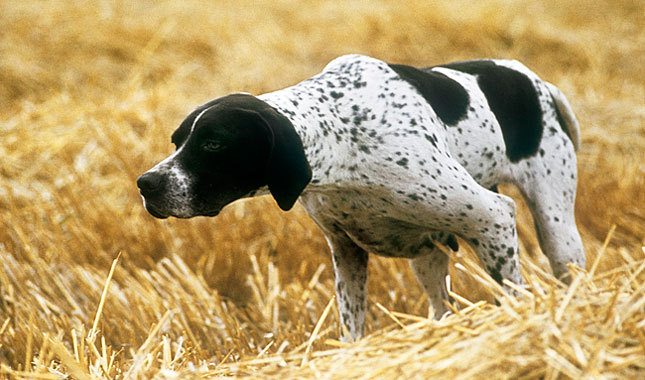
Once the breed crossed the Atlantic and was recognized by the American Kennel Club, its popularity rose even more.
Appearance and Size
Prospective dog owners should look at the different physical traits when considering getting a pet for their household. These two are quite different visually. They were bred for different roles. While they are similar in terms of working ability, they have different roles. Hence, different looks. Let’s take a closer look at what makes each breed unique in these areas.
Coat Characteristics
Looking at the coat of the Australian Cattle Dog, we can see its uniqueness. Featuring a short coat that can be blue mottled, blue speckled, red speckled, or red mottled, Australian Cattle Dogs are known either as Blue Heelers or Red Heelers. Their shorter coat is easy to maintain, compared to some long-haired breeds.
On the other hand, the English Pointer has a coat that shows off a range of colors including liver, lemon, black, and orange. It can be solid or mottled with different markings. They also have short coats which can be sleek and shiny.
Ears and Eyes
These two breeds have kind expressions coming from their eyes. The Australian Cattle Dog’s eyes are usually dark and alert, while the English Pointer’s eyes are round and can be hazel or brown, depending on the coat color.
Ears are another distinct feature. The Australian Cattle Dog has ears that are wide apart and pricked, indicating their focused nature.
Meanwhile, the English Pointer, with its ears set high on the head, has ears that hang down, giving them a noble profile.
Breed Sizes
| Breed | Height (inches) | Weight (pounds) |
|---|---|---|
| Australian Cattle Dog | 17 – 20 | Medium size; varies |
| English Pointer | Up to 28 | Medium to large; generally heavier than Australian Cattle Dog |
The Australian Cattle Dog is considered a medium breed. Compared to the Pointer, they are lack up to 7 inches. As for weight, they can be about 39 pounds lighter than their English Pointer counterparts.
On the other hand, the English Pointer stands taller and is part of the medium to large size category, making them more imposing in stature. This breed may offer a significant presence due to its height and weight compared to the Australian Cattle Dog.
Temperament and Personality
Due to their different roles and origin, these two have a different personality. What are some of their unique personality traits? Let’s take a look.
Australian Cattle Dog Temperament
Praised as one of the smartest dog in the world, the Australian Cattle dog is a true definition of a working companion.
Originally bred to herd cattle, they pick up things on the fly. They thrive when they have a job to do. As a herding dog breed, Cattle Dogs have plenty of energy. They love to be on the move at all times.
If you want a couch potato, this is definitely a dog you should avoid. Cattle Dogs need plenty of physical and mental exercise to stay happy.
- Loyal: Form strong attachment and bond with their dog owner
- Protective: Their alertness makes them natural guard dogs
- Affectionate: In the household, they are full of love for their family and show their softer side
English Pointer Personality
English Pointers, on the other hand, carry an air of grace and athleticism. Bred for hunting, these dogs can easily locate game.
When you think about it, the Australian Cattle Dog is an on-the-go herder, and the English Pointer is more like a skilled athlete—streamlined and built for stamina.
English Pointers bring a kind and patient demeanor to the table. They tend to be loving and enjoy being part of the family’s daily activities.
- Active: They love to run and have a deep well of energy, especially outdoors
- Intelligent and Alert: English Pointers are quick learners, and they’re always paying attention to their surroundings
- Watchdog Potential: While they may be friendly, they’re also protective and can be counted on to alert you to anything unusual
Exercise and Activity Needs
When it comes to keeping a dog happy and healthy, how much they need to run around and play is super important.
Australian Cattle Dogs and English Pointers might both love to stay active, but the way they move and the kind of play they need are quite different. Let’s dig into what keeps each of these dog breeds wagging their tails.
Cattle Dog Exercise
Australian Cattle Dogs are little balls of energy. They need a good deal of exercise every day.
We’re not just talking a lazy stroll around the block; these pups are built for action. They usually love games that get their muscles moving and their minds working.
A fenced yard is a fantastic place for a Cattle Dog to zip around and play a game of fetch. But even with a yard, they need their human pals to keep things fun and interesting.
Here’s a quick peek at what might make their tails wag:
- Daily Exercise Time: 60-90 minutes
- Favorite Activities: Agility exercises, fetch
Pointer Activity Levels
English Pointers, on the other hand, have the speed of an athlete and the heart of an explorer.
Physical bursts like sprinting after a thrown ball or racing through open spaces are where they shine. Their love for movement makes them a great match for folks who enjoy outdoor activities.
English Pointers will be grateful for a place to stretch their legs.
Remember, it’s not just about giving them space; it’s also about spending quality time together:
- Daily Exercise Time: At least 1-2 hours
- Favorite Activities: Running, exploring wide, open spaces
Training and Intelligence
It is a huge challenge to train a smart dog. Some pet parents think a smart dog can pick up things easily. Yes, that is true. But what is also true is that a smart dog will try to outsmart you. And gets bored easily. You have to up your game to provide enough stimulation and challenge for your working dog to want to train.
Let’s chat about what makes training each dog breed a unique experience and how their smarts play out in learning new tricks.
Ease of Training
Training a Australian Cattle Dog can be a smooth ride since they pick up on things quickly, thanks to their sharp minds.
They’re eager to do their job and aim to please, making them a good match for owners who can offer consistent guidance. You’ve gotta keep it clear and steady, though; they don’t take kindly to mixed messages. Australian Cattle Dogs are some of the smartest herding dogs around, alongside the Australian Shepherd and Border Collie. All of them love working and training, but they need an owner who will stimulate them.
On the other hand, the English Pointer is a tad more laid back but still takes well to dog training when you keep things positive.
Like their canine counterparts, they dig a routine that doesn’t chop and change. Being patient and using treats or a good old “Well done!” can go a long way with these pups.
Intelligence Insights
Let’s talk smarts.
The Australian Cattle Dog is pretty much the nerd of the dog park. They’re not just brainy; they’re problem-solvers who can work through a situation.
To keep their mind ticking, they love puzzles and challenges that keep them thinking.
The English Pointer has got the brains too, especially when it’s about the task they know best: hunting.
They’ve got this natural knack for it and love an opportunity to learn complex obedience commands. But remember, like any smart pup, they’ll need mental play to keep those neurons firing.
Health and Lifespan
When choosing between the Australian Cattle Dog vs English Pointer, prospective dog owners need to consider how long they might be part of the family. What are some of the possible health issues and risks? Once you understand your pet’s health and lifespan, you can find a way to give them a happy and healthy life.
Common Health Issues
Working and herding dogs are usually healthy dogs. The same applies to the Australian Cattle Dogs and English Pointers. Yet, they are prone to some health risks.
For Australian Cattle Dogs, that is hip dysplasia. This is a condition where the hip joint doesn’t fit together perfectly. As a result, dogs feel discomfort and face mobility issues. They are also at risk for progressive retinal atrophy, which can lead to blindness if not caught early on.
English Pointers can be prone to allergies that might flare up due to various triggers, including certain foods or environmental factors like dust or pollen.
- Australian Cattle Dog Health Concerns:
- Hip dysplasia
- Progressive retinal atrophy
- English Pointer Health Concerns:
- Allergies
Managing Health
To keep these puppies healthy, regular check-ups with a trusted vet are a must.
They need their exercise too—keeping them active can help manage weight and support hip health.
For those Australian Cattle Dogs with a risk of progressive retinal atrophy, early screening is key. It’s like catching a problem before it gets too big.
When it gets super hot or cold, remember that both breeds can find this tough. They may need a cool spot in the shade or a warm bed, depending on the weather.
Provide a balanced diet and watch for signs of health issues like stiffness or changes in vision, and you’re on your way to giving them a good, long life.
- Tips for Managing Their Health:
- Regular vet check-ups
- Plenty of exercises
- Early screening for inheritable conditions
- Protection from extreme weather
- A nutritious diet
Care and Grooming
When it comes to keeping both the Australian Cattle Dog and the English Pointer looking their best, it’s all about regular care. They have different needs, though, from the kind of brushing to how much they need to run and play.
Grooming Needs
Australian Cattle Dog:
- Coat: They sport a short, weather-resistant double coat
- Brushing: At least once a week is ideal, with a bristle brush or grooming mitt
- Bathing: Every other week to every 8 weeks can keep them clean and reduce doggie odor
- Shedding: They do shed, so regular grooming will help manage loose hair
English Pointer:
- Coat: Their coat is also short but less dense than that of the Australian Cattle Dog
- Brushing: They require less frequent brushing compared to the Australian Cattle Dog
- Bathing: Bathe only as necessary, as over-bathing can strip their coat of natural oils
- Shedding: While they shed, it’s generally less than their Australian counterparts
Exercise Requirements
Australian Cattle Dog:
- Energy Level: High energy levels, bred to herd cattle
- Exercise: They need vigorous daily exercise to be happy and healthy
English Pointer:
- Energy Level: Active dogs with ample energy to burn
- Exercise: They need regular, daily physical activities to satisfy their natural hunting instincts
Keeping these dogs groomed and well-exercised not only keeps them looking sharp but also goes a long way to ensuring they are content and well-behaved companions.
Remember, a tired dog is often a good dog, and when they’re well cared for, they shine just like their coats.
Compatibility with Families
When it comes to fitting into family life, Australian Cattle Dogs and English Pointers have their unique traits. They both can be loving members of the family but have different needs and characteristics that affect how well they mesh with home life, especially with children and other pets, as well as how they adapt to different living spaces.
With Children and Other Pets
Australian Cattle Dogs are known for their energy and playfulness, making them fantastic playmates for children. However, because they were bred to herd cattle, they might try to herd small kids by nipping at their heels.
Close supervision and proper dog training are essential to make sure playtime is safe and fun.
- English Pointers, on the other hand, are typically gentle and patient with children. They can be boisterous due to their hunting background; therefore, interactions with very small children should be monitored to prevent accidental knocks
Both breeds can co-exist with other pets if they’re raised together, though early socialization is key.
Australian Cattle Dogs have a strong prey drive and may chase smaller animals, whereas English Pointers might show a strong interest in birds or small pets, given their hunting heritage.
- Australian Cattle Dog
- Playful with kids
- Might nip when herding
- Can live with other pets (if raised together)
- High prey drive (caution advised)
- English Pointer
- Gentle and patient with kids
- Can be boisterous around small children
- Usually okay with other pets
- Interest in birds/small animals due to hunting instincts
Adaptation to Living Spaces
While Australian Cattle Dogs are flexible and can adapt to various living environments, including apartments, they need ample exercise to keep from being destructive. They thrive in a setting where they can move and play.
English Pointers also need plenty of daily exercise but are generally more laid back inside the home. Given their size and high energy levels when outdoors, they may do best in a home with a large yard.
- Australian Cattle Dog: Suitable for both indoor and outdoor, but loves to have a yard to roam
- English Pointer: Thrives in a with more space, but can live indoor when you provide enough exercise
Choosing the Right Dog for You
When choosing between an Australian Cattle Dog and an English Pointer, it’s crucial to consider your lifestyle and the level of time and money commitment each breed requires.
Lifestyle Considerations
Australian Cattle Dogs and English Pointers are both active breeds, but they fit into different kinds of living situations.
Cattle Dogs are compact and might fit into smaller spaces, but they need plenty of exercise and tasks to do, as they get bored easily.
They’re strong-minded and typically not a great choice for first-time dog owners due to their independent nature and need for consistent training.
On the flip side, English Pointers are larger and require ample space to move about, perfect for someone with a big yard. They are affectionate and good with families but share a high energy level that demands long, active walks or runs.
Cost and Commitment
| Factor | Australian Cattle Dog | English Pointer |
|---|---|---|
| Average Price | $600 – $1,000 | $700 – $1,200 |
| Activity Needs | High, needs a job to do | Very high, needs space and exercise |
| Good with Families? | Yes, if socialized properly | Yes, generally |
| Novice Owners? | Not recommended | Might be okay with training |
Both dog breeds require a significant financial commitment. You’ll need to budget for their food, vet care, and other needs over their lifetime. They both have roughly the same lifespan, so you’re in it for the long haul with either breed.
If cost is a big deciding factor, remember, it’s often about more than just the initial price tag. Think long-term care costs, too.

